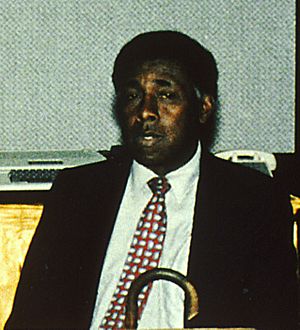Harold Amos facts for kids
Quick facts for kids
Harold Amos
|
|
|---|---|
 |
|
| Born | September 7, 1918 Pennsauken, New Jersey
|
| Died | February 26, 2003 (aged 84) Boston, Massachusetts
|
| Nationality | American |
| Alma mater | Springfield College Harvard Medical School |
| Scientific career | |
| Fields | Microbiology |
| Institutions | Harvard Medical School |
| Thesis | (1952) |
| Doctoral advisor | Howard J. Mueller |
Harold Amos (born September 7, 1918 – died February 26, 2003) was an amazing African American scientist. He was a microbiologist, which means he studied tiny living things like bacteria. Dr. Amos was also a professor at Harvard Medical School for almost 50 years. He made history as the first African American to lead a department at that famous school.
Contents
Harold Amos's Early Life
Harold Amos was born in Pennsauken, New Jersey. His father, Howard R. Amos Sr., was a postman. His mother, Iola Johnson, was adopted and raised by a Quaker family in Philadelphia.
Because of his mother's family, Harold's family received many books. One of these books was about Louis Pasteur, a famous scientist. This likely sparked Harold's interest in science.
Harold was a brilliant student. In 1936, he graduated at the top of his class from Camden High School. He then went to Springfield College in Massachusetts. He earned a full scholarship to study there.
In 1941, he graduated with top honors. He earned a degree in biology and a minor in chemistry.
Military Service in World War II
Harold Amos was drafted into the US Army in 1942. He served in the Quartermaster's Corps during World War II. He was a warrant officer, which is a special rank.
During his time in the Army, he traveled along the coast of France. He became very good at speaking French. He also learned a lot about French foods and wines. He was discharged from the Army in February 1946.
Harold Amos's Amazing Career
After the war, Harold Amos began his graduate studies at Harvard University. In 1952, he made history again. He was the first African American to earn a doctoral degree from Harvard Medical School's Division of Medical Sciences.
His doctoral research was on how the Herpes virus causes infections. After getting his degree, he received a special Fulbright scholarship. This allowed him to study at the Pasteur Institute for two years.
Teaching at Harvard
Dr. Amos joined the Harvard Medical School faculty in 1954. He was a dedicated teacher and researcher. From 1968 to 1971, he was the chairman of the bacteriology department. He held this important role again from 1975 to 1978.
In 1975, he became the Maude and Lillian Presley professor of microbiology and molecular genetics. He was also an advisor to President Richard Nixon. He was a member of many important groups, including the American Academy of Arts and Sciences.
In 1988, he became a professor emeritus. This means he retired but kept his title because of his great contributions.
Awards and Recognition
Harold Amos received many awards for his work. In 1995, he was given the National Academy of Sciences' Public Welfare Medal. In 2000, he received the Harvard Centennial Medal.
After retiring from Harvard, he led a program called the Minority Medical Faculty Development Program. This program helped many minority students become doctors and medical professors.
Dr. Amos was known for being a welcoming mentor. He inspired hundreds of minority students to pursue careers in medicine. Harvard Medical School even has an award named after him to celebrate diversity.
Awards and Honors
Harold Amos received many important awards during his career:
- Howard University’s Dr. Charles R. Drew World Medical Prize in 1989
- National Academy of Sciences' Public Welfare Medal in 1995
- Harvard Centennial Medal in 2000
- Fellow of the American Academy of Arts and Sciences
- Fellow of the American Association for the Advancement of Science
Harold Amos Medical Faculty Development Program
The Robert Wood Johnson Foundation works to make health care better for everyone in America. They wanted to help more minority students become health care professionals.
They noticed that many talented minority medical residents could become medical school professors. But they needed help connecting with good mentors. So, in 1983, the Foundation started the Minority Medical Faculty Development Program.
In 2004, this program was renamed the Harold Amos Medical Faculty Development Program (AMFDP). It was named in honor of Dr. Amos, who was its first director.
Impact of the Program
Harold Amos believed this program would help minority students get the same chances he had. He wanted to share his knowledge with others. The program has helped many minority students succeed in medical careers.
Between 2003 and 2008, the program helped over 124 participants. These students gained leadership skills and received grants. These grants covered a large part of their school costs.
Dr. James Gavin III, a famous alumni of the program, said it was an honor to be part of it. He believed the program helped create many brilliant young doctors and dentists. He felt it helped build a strong group of talented people in academic medicine.

